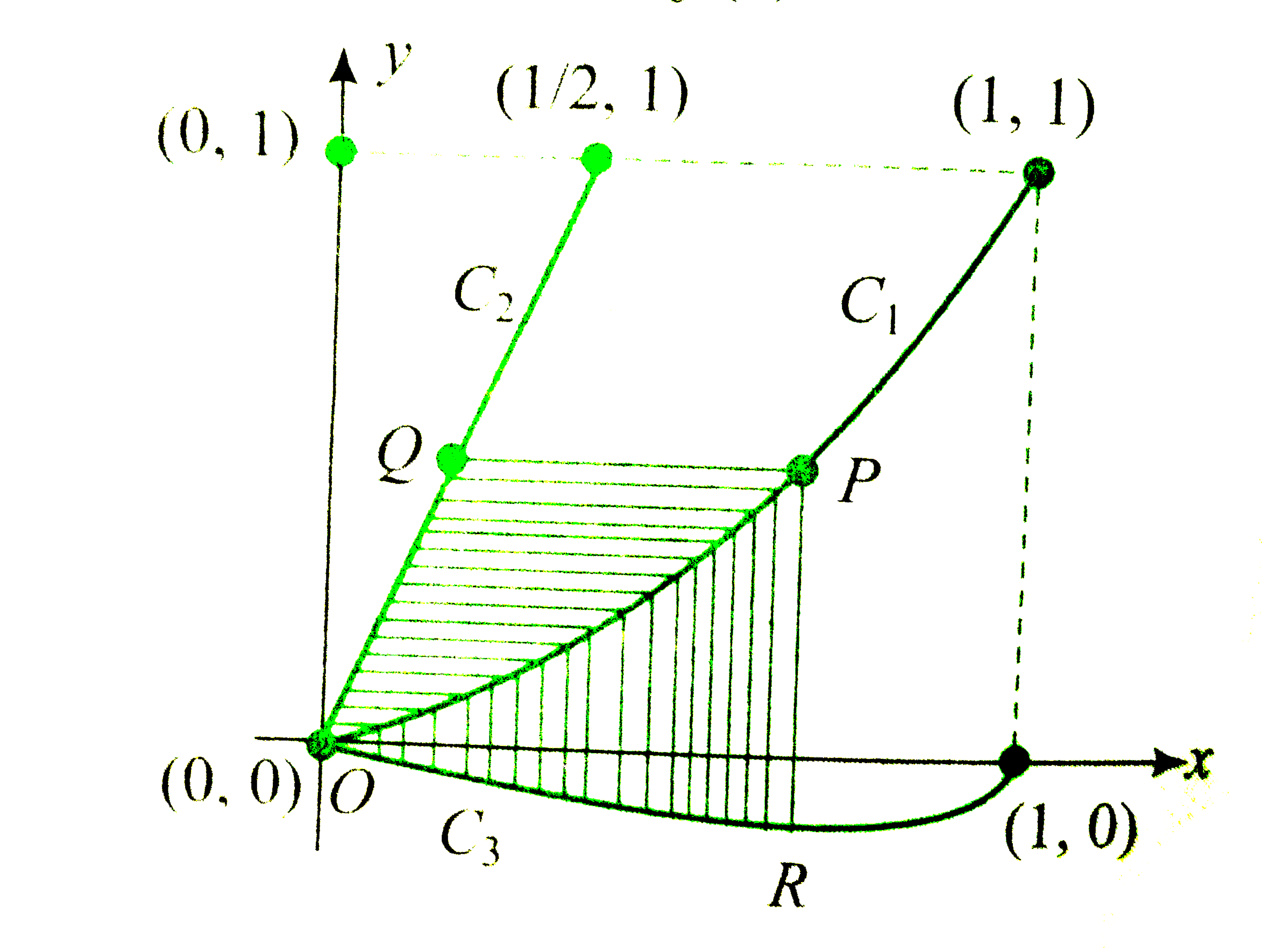Let C1andC2 be the graphs of the functions y=x2andy=2x, respectively, where 0≤x≤1. Let C3 be the graph of a function y=f(x), where 0≤x≤1,f(0)=0. For a point P on C1, let the lines through P, parallel to the axes, meet C2andC3 at Q and R, respectively (see figure). If for every position of P(onC1), the areas of the shaded regions OPQ and ORP are equal, determine the function f(x).

The correct Answer is:fx=x3−x2
Step by step video & image solution for Let C_(1) and C_(2) be the graphs of the functions y=x^(2) and y=2x, respectively, where 0le x le 1." Let "C_(3) be the graph of a function y=f(x), where 0lexle1, f(0)=0. For a point P on C_(1), let the lines through P, parallel to the axes, meet C_(2) and C_(3) at Q and R, respectively (see figure). If for every position of P(on C_(1)), the areas of the shaded regions OPQ and ORP are equal, determine the function f(x). by Maths experts to help you in doubts & scoring excellent marks in Class 12 exams.
Topper's Solved these Questions
- BOOK - ARIHANT MATHS ENGLISHCHAPTER - AREA OF BOUNDED REGIONSEXERCISE - Exercise For Session 110videos
AREA OF BOUNDED REGIONS
- BOOK - ARIHANT MATHS ENGLISHCHAPTER - AREA OF BOUNDED REGIONSEXERCISE - Exercise For Session 219videos
AREA OF BOUNDED REGIONS
- BOOK - ARIHANT MATHS ENGLISHCHAPTER - BIONOMIAL THEOREMEXERCISE - Exercise (Questions Asked In Previous 13 Years Exam)21videos
BIONOMIAL THEOREM
Similar Questions
Let C1C2 be the graphs of the functions y=x2 and y=2x, respectively, where 0≤x≤1. Let C3 be the graph of a function y=f(x), where 0≤x≤1,f(0)=0. For a point P on C1, let the lines through P, parallel to the axis, meet C2 and C3 at Q and R, respectively (see Figure). If for every position of P(onC1), the areas of the shaded regions OPQ and ORP are equal, determine the function f(x)
View SolutionLet C be the centroid of the triangle with vertices (3, -1) (1, 3) and ( 2, 4). Let P be the point of intersection of the lines x+3y−1=0 and 3x−y+1=0. Then the line passing through the points C and P also passes through the point :
View SolutionLet f(x)= max {x2,(1−x)2,2x(1−x)} where 0≤x≤1. Determine the area of the region bounded by y=f(x), x-axis, x = 0 and x = 1.
View SolutionTwo circles C1 and C2 intersect at two distinct points PandQ in a line passing through P meets circles C1andC2 at AandB , respectively. Let Y be the midpoint of AB and QY meets circles C1 andC2 at Xa n dZ respectively. Then prove that Y is the midpoint of XZ
View SolutionThe circle C1 :x2+y2=3, with center at O, intersects the parabolax2=2y at the point P in the first quadrant. Let the tangent to the circle C1 at P touches other two circles C2 and C3 at R2 and R3, respectively. Suppose C2 and C3 have equal radii 2√3 and centers Q2 and Q3, respectively.If Q2andQ3 lies on the y-axis, then
View SolutionLet C1 and C2 be parabolas x2=y−1 and y2=x−1 respectively. Let P be any point on C1 and Q be any point C2. Let P1 and Q1 be the reflection of P and Q, respectively w.r.t the line y = x then prove that P1 lies on C2 and Q1 lies on C1 and PQ≥[PP1,QQ1]. Hence or otherwise , determine points P0 and Q0 on the parabolas C1 and C2 respectively such that P0Q0≤PQ for all pairs of points (P,Q) with P on C1 and Q on C2
View SolutionLet C1 and C2 be respectively, the parabolas x2=y−1 and y2=x−1 Let P be any point on C1 and Q be any point on C2 . Let P1 and Q1 be the refelections of P and Q, respectively with respect to the line y=x.
If the point p(π,π2+1) and Q(μ2+1,μ) then P1 and Q1 areView SolutionLet C1 and C2 be respectively, the parabolas x2=y−1 and y2=x−1 Let P be any point on C1 and Q be any point on C2 . Let P1 and Q1 be the refelections of P and Q, respectively with respect to the line y=x.
Arithemetic mean of PP1and QQ1 is always less thanView SolutionLet C be a circle with centre P0andAB be a
diameter of C . suppose P1 is the midpoint of line
segment P0B,P2 the midpoint of line segment
P1B and so on Let C1,C2,C3 be circles with diameters P0P1,P1P2,P2P3 ,... respectively
Suppose the circles C1,C2,C2,... are all shaded
The ratio of the area of the unshaded portion of C
to that of the original circle isView SolutionLet the circles
S1≡x2+y2+4y−1=0
S2≡x2+y2+6x+y+8=0
touch each other . Also, let P1 be the point of contact of S1 and S2, C1 and C2 are the centres of S1andS2 respectively.
The coordinates of P1 areView Solution

